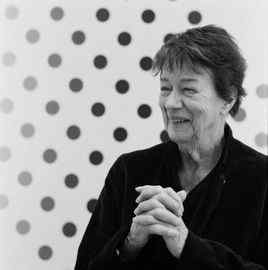Bridget Riley’s intricate, stylish geometric abstractions helped pioneer the Op Art movement in the 1960s. The British painter arrayed colorful shapes across her canvases in a way that induced the appearance of vibration or movement; such optical effects gave Op Art its name. Though Riley created some black-and-white canvases early in her career, she is better known for compositions that feature jubilant hues. Riley studied at Goldsmiths’ College and the Royal College of Art and worked briefly in advertising before transitioning to full-time artmaking. She has exhibited in London, New York, Los Angeles, Paris, Shanghai, Tokyo, and Hong Kong, among many other cities. Her work belongs in the collections of institutions including Arts Council England, the Centre Pompidou, the Metropolitan Museum of Art, the Tate, and the Stedelijk Museum and has fetched millions of dollars on the secondary market.


